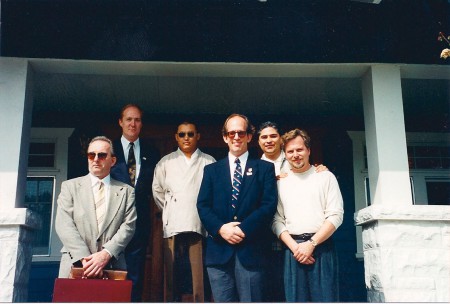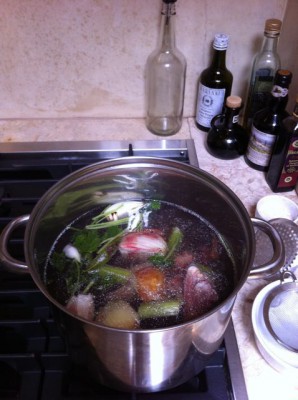Call Me Machen
Who cooks for Sakyong Mipham Rinpoche? Every sentient being needs to be nourished. Eating is one of the most ordinary and necessary everyday acts. Guy Blume sheds light on what it is like to be the one who feeds the teacher.
A few years ago, never mind how many, I became a machen. Machen is an odd word among the many strange titles that are awarded to the citizens of Shambhala and is infrequently referred to. The machens are a branch of the Dorje Kasung and we are the cooks. More specifically we are the personal cooks to Sakyong Mipham Rinpoche and the Sakyong Wangmo. Machens are not brought up through the ranks of the military but are appointed. When I first met the Sakyong around 1994 he stayed in the house of a sangha member and I cooked for him. Back then the Sakyong had not begun his rigorous physical regiment. He enjoyed rich foods on a daily basis and his appearance was more rounded. I fed him a variety of exotic, fully flavored dishes. Apparently I made a favorable impression for when I went to seminary five years later he remembered me and asked me to be a machen.

Sakyong Mipham Rinpoche, (lineage holder of Shambhala) third from left. Guy Blume (author and Sakyongs personal chef in 1994), far right.
I had grown up in a home were we celebrated food. My parents loved to stop at roadside vegetable stands for fresh strawberries, tomatoes or watermelons. At dinner we discussed if the sweet corn of summer was really at its peak yet. We ate salmon fished from Glacier Bay by my father or lamb raised on the eastern plains of Colorado by Bobby our tenant farmer. It seemed like a natural progression that I should go on to work for a catering company and to eventually run a large kitchen as an executive chef. I came to the role of machen with years of experience and knowledge.
 My first tour of duty as machen was four weeks during a summer program at Shambhala Mountain Center (SMC). The Sakyong was leading a vajrayana seminary at SMC and staying at Prajna, the residence that has since burned down. The staff stayed in tents at the nearby campground Upaya. It was the summer of mice and the tents were over-run with rodents looking for food. They chewed through wool shawls and suits with abandon. Fortunately my cat had slept frequently on my suitcase when it was stored in the garage and her scent kept the mice away. I was sharing the cooking duties with another first time machen Joe Shea. He was east coast and I was west coast. We joked that we should have an Iron Chef style cook off.
My first tour of duty as machen was four weeks during a summer program at Shambhala Mountain Center (SMC). The Sakyong was leading a vajrayana seminary at SMC and staying at Prajna, the residence that has since burned down. The staff stayed in tents at the nearby campground Upaya. It was the summer of mice and the tents were over-run with rodents looking for food. They chewed through wool shawls and suits with abandon. Fortunately my cat had slept frequently on my suitcase when it was stored in the garage and her scent kept the mice away. I was sharing the cooking duties with another first time machen Joe Shea. He was east coast and I was west coast. We joked that we should have an Iron Chef style cook off.
Joe and I were both anxious about cooking for the Sakyong. Joe tried to hide his nerves behind a sophisticated New York bravado and I attempted a cool, west coast detachment. For the Sakyong’s first meal we collaborated on one of his favorites, a rib eye steak, salad and vegetables. Simple. After the meal was plated and served the Sakyong called us into the dining room. As we sat there and watched him saw at the thick cut of meat he asked us questions like, “how are your tents?” “ Are you sleeping well?” Finally I realized that as he pushed the steak around his plate it was nearly raw. I asked him if I could cook it a little more for him.Machen practice is like Kasang practice. We are required to hold the container of the kitchen in the court. We are asked to bring mindfulness to our situation, specifically to the preparation and cooking of meals and we need to bring consciousness to our discursiveness.
The guru has a big mind that is spacious and vast. In the atmosphere of the court, the expression of the machen can be either immense or claustrophobic. When in close proximity to the guru’s mind it is easy to get lost in space or feel the tightness of our own neurosis.
Since the Sakyong has begun running and has slimmed down to a trim athletic build he has become highly conscious of his diet. He eats very cleanly and mindfully. He knows when he is full and stops eating. Since he travels so much he strives to keep his diet consistent and simple.
Recently he came to San Francisco and I cooked for him. Upon his arrival he asked the same question he usually asks. Does the kitchen have a gas stove? I always wonder if he asks the question because he knows it is easier to cook on gas or is he asking if there is a fire element in the kitchen?
Again on the visit, he asked me to cook a rib eye for him. The residence had a giant, outdoor gas grill. I fired the grill up, put the steak down and promptly lost my mind. My concept of time became confused and couldn’t decide if the steak had been on the fire two minutes or ten. I became terrified that I would overcook it. At some point I decided it was done and plated it for the Sakyong. The server served it to him and few minutes later the Sakyong called me into the dining room. He asked me if I could but the steak back on the grill for a few more minutes…
 Guy Blume has been a Shambhala Buddhist practitioner for 20 years. He is a meditation instructor and a kado practitioner. He is also the regional head of Culture and Decorum. Guy is also a graduate of Parsons School of Design. In 2009 he formed his own interior design company where he incorporates the principles of the Five Buddha Families and Maitri Space Awareness into his work.
Guy Blume has been a Shambhala Buddhist practitioner for 20 years. He is a meditation instructor and a kado practitioner. He is also the regional head of Culture and Decorum. Guy is also a graduate of Parsons School of Design. In 2009 he formed his own interior design company where he incorporates the principles of the Five Buddha Families and Maitri Space Awareness into his work.
